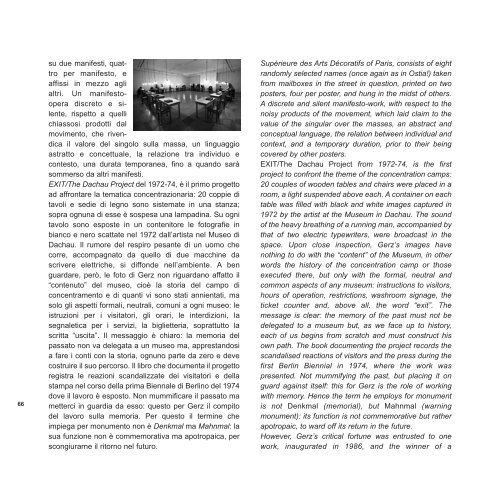Adachiara Zevi - arteinmemoria
Adachiara Zevi - arteinmemoria
Adachiara Zevi - arteinmemoria
You also want an ePaper? Increase the reach of your titles
YUMPU automatically turns print PDFs into web optimized ePapers that Google loves.
66<br />
su due manifesti, quattro<br />
per manifesto, e<br />
affissi in mezzo agli<br />
altri. Un manifestoopera<br />
discreto e silente,<br />
rispetto a quelli<br />
chiassosi prodotti dal<br />
movimento, che rivendica<br />
il valore del singolo sulla massa, un linguaggio<br />
astratto e concettuale, la relazione tra individuo e<br />
contesto, una durata temporanea, fino a quando sarà<br />
sommerso da altri manifesti.<br />
EXIT/The Dachau Project del 1972-74, è il primo progetto<br />
ad affrontare la tematica concentrazionaria: 20 coppie di<br />
tavoli e sedie di legno sono sistemate in una stanza;<br />
sopra ognuna di esse è sospesa una lampadina. Su ogni<br />
tavolo sono esposte in un contenitore le fotografie in<br />
bianco e nero scattate nel 1972 dall’artista nel Museo di<br />
Dachau. Il rumore del respiro pesante di un uomo che<br />
corre, accompagnato da quello di due macchine da<br />
scrivere elettriche, si diffonde nell’ambiente. A ben<br />
guardare, però, le foto di Gerz non riguardano affatto il<br />
“contenuto” del museo, cioè la storia del campo di<br />
concentramento e di quanti vi sono stati annientati, ma<br />
solo gli aspetti formali, neutrali, comuni a ogni museo: le<br />
istruzioni per i visitatori, gli orari, le interdizioni, la<br />
segnaletica per i servizi, la biglietteria, soprattutto la<br />
scritta “uscita”. Il messaggio è chiaro: la memoria del<br />
passato non va delegata a un museo ma, apprestandosi<br />
a fare i conti con la storia, ognuno parte da zero e deve<br />
costruire il suo percorso. Il libro che documenta il progetto<br />
registra le reazioni scandalizzate dei visitatori e della<br />
stampa nel corso della prima Biennale di Berlino del 1974<br />
dove il lavoro è esposto. Non mummificare il passato ma<br />
metterci in guardia da esso: questo per Gerz il compito<br />
del lavoro sulla memoria. Per questo il termine che<br />
impiega per monumento non è Denkmal ma Mahnmal: la<br />
sua funzione non è commemorativa ma apotropaica, per<br />
scongiurarne il ritorno nel futuro.<br />
Supérieure des Arts Décoratifs of Paris, consists of eight<br />
randomly selected names (once again as in Ostia!) taken<br />
from mailboxes in the street in question, printed on two<br />
posters, four per poster, and hung in the midst of others.<br />
A discrete and silent manifesto-work, with respect to the<br />
noisy products of the movement, which laid claim to the<br />
value of the singular over the masses, an abstract and<br />
conceptual language, the relation between individual and<br />
context, and a temporary duration, prior to their being<br />
covered by other posters.<br />
EXIT/The Dachau Project from 1972-74, is the first<br />
project to confront the theme of the concentration camps:<br />
20 couples of wooden tables and chairs were placed in a<br />
room, a light suspended above each. A container on each<br />
table was filled with black and white images captured in<br />
1972 by the artist at the Museum in Dachau. The sound<br />
of the heavy breathing of a running man, accompanied by<br />
that of two electric typewriters, were broadcast in the<br />
space. Upon close inspection, Gerz’s images have<br />
nothing to do with the “content” of the Museum, in other<br />
words the history of the concentration camp or those<br />
executed there, but only with the formal, neutral and<br />
common aspects of any museum: instructions to visitors,<br />
hours of operation, restrictions, washroom signage, the<br />
ticket counter and, above all, the word “exit”. The<br />
message is clear: the memory of the past must not be<br />
delegated to a museum but, as we face up to history,<br />
each of us begins from scratch and must construct his<br />
own path. The book documenting the project records the<br />
scandalised reactions of visitors and the press during the<br />
first Berlin Biennial in 1974, where the work was<br />
presented. Not mummifying the past, but placing it on<br />
guard against itself: this for Gerz is the role of working<br />
with memory. Hence the term he employs for monument<br />
is not Denkmal (memorial), but Mahnmal (warning<br />
monument): its function is not commemorative but rather<br />
apotropaic, to ward off its return in the future.<br />
However, Gerz’s critical fortune was entrusted to one<br />
work, inaugurated in 1986, and the winner of a


